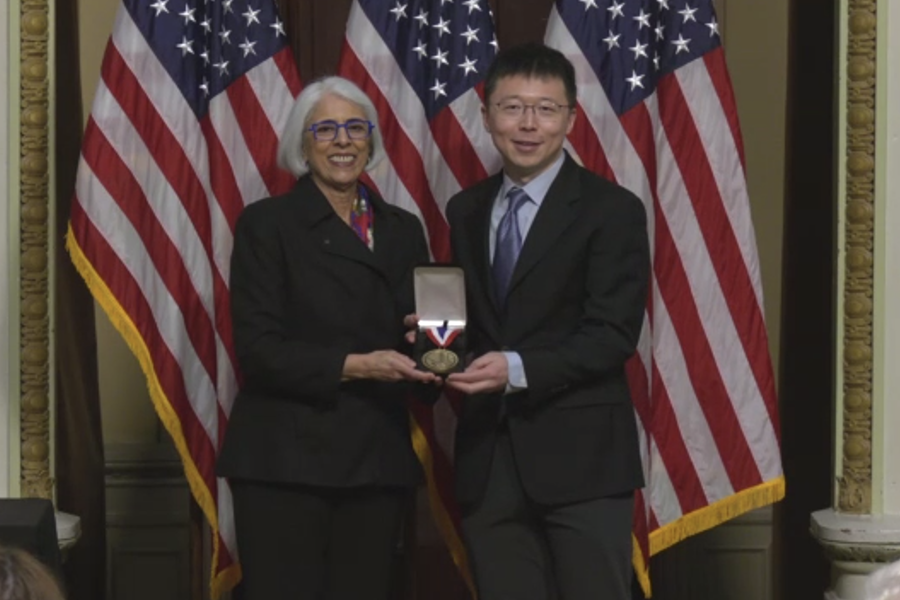Feng Zhang awarded 2024 National Medal of Technology
McGovern Investigator honored with nation’s highest award for scientists and engineers.

This post is adapted from an MIT News story.
***
Feng Zhang, the James and Patricia Poitras Professor of Neuroscience at MIT and an Investigator at the McGovern Institute, has won the National Medal of Technology and Innovation, the nation’s highest recognition for scientists and engineers. The prestigious award recognizes “American innovators whose vision, intellect, creativity, and determination have strengthened America’s economy and improved our quality of life.”
Zhang, who is also a professor of brain and cognitive sciences and biological engineering at MIT, a core member of the Broad Institute of MIT and Harvard, and an investigator with the Howard Hughes Medical Institute, was recognized for his work developing molecular tools, including the CRISPR genome-editing system, that have accelerated biomedical research and led to the first FDA-approved gene editing therapy.
This year, the White House awarded the National Medal of Science to 14 recipients and named nine individual awardees of the National Medal of Technology and Innovation, along with two organizations. Zhang is among four MIT faculty members who were awarded the nation’s highest honors for exemplary achievement and leadership in science and technology.
Designing molecular tools
Zhang, who earned his undergraduate degree from Harvard University in 2004, has contributed to the development of multiple molecular tools to accelerate the understanding of human disease. While a graduate student at Stanford University, from which he received his PhD in 2009, Zhang worked in the lab of Professor Karl Deisseroth. There, he worked on a protein called channelrhodopsin, which he and Deisseroth believed held potential for engineering mammalian cells to respond to light.
The resulting technique, known as optogenetics, is now used widely used in neuroscience and other fields. By engineering neurons to express light-sensitive proteins such as channelrhodopsin, researchers can either stimulate or silence the cells’ electrical impulses by shining different wavelengths of light on them. This has allowed for detailed study of the roles of specific populations of neurons in the brain, and the mapping of neural circuits that control a variety of behaviors.
In 2011, about a month after joining the MIT faculty, Zhang attended a talk by Harvard Medical School Professor Michael Gilmore, who studies the pathogenic bacterium Enteroccocus. The scientist mentioned that these bacteria protect themselves from viruses with DNA-cutting enzymes known as nucleases, which are part of a defense system known as CRISPR.
“I had no idea what CRISPR was, but I was interested in nucleases,” Zhang told MIT News in 2016. “I went to look up CRISPR, and that’s when I realized you might be able to engineer it for use for genome editing.”
In January 2013, Zhang and members of his lab reported that they had successfully used CRISPR to edit genes in mammalian cells. The CRISPR system includes a nuclease called Cas9, which can be directed to cut a specific genetic target by RNA molecules known as guide strands.
Since then, scientists in fields from medicine to plant biology have used CRISPR to study gene function and modify faulty genes that cause disease. More recently, Zhang’s lab has devised many enhancements to the original CRISPR system, such as making the targeting more precise and preventing unintended cuts in the wrong locations. In 2023, the FDA approved Casgevy, a CRISPR gene therapy based on Zhang’s discoveries, for the treatment of sickle cell disease and beta thalassemia.
The National Medal of Technology and Innovation was established in 1980 and is administered for the White House by the U.S. Department of Commerce’s Patent and Trademark Office. The award recognizes those who have made lasting contributions to America’s competitiveness and quality of life and helped strengthen the nation’s technological workforce.



